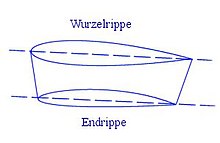Set (aerodynamics)
The twist is that structural distortion of the wings , the one favorable to the flight characteristics of the aircraft behavior in case of a stall purpose. This can be done through geometric or aerodynamic adjustment.
By increasing the angle of attack during the flight it comes from a certain angle to the flow separation and the loss of dynamic lift . The aim of the twist is to achieve a gradual loss of lift - as opposed to an abrupt one over the entire wing.
The intention is that when the angle of attack is increased, the flow will initially only stall in the area of the wing root , but the outside airfoil parts will still be flown normally and generate lift. The aircraft can still be controlled by the ailerons, which are also on the outside. In addition, a stall, which may only occur on one wing tip, is much more difficult to intercept.
Geometric set
When building the wing, the outer profile rib, also called the end rib, is turned downwards with the leading edge in relation to the inner profile rib, also known as the root rib. The root and end ribs have the same profile with the same maximum angle of attack, but this is reached first in the area of the surface root (inside). This means that when the surface is covered, there is a continuous tear, starting at the surface root. You change the angle of incidence along the wing. The angle of incidence is measured between the aircraft longitudinal axis and the profile chord. The setting angle is structurally fixed and cannot be changed. In the case of the geometric twist, the angle of incidence is greatest at the wing root and becomes smaller towards the wing tip. The wing profile remains unchanged here. The advantage over the aerodynamic twist is the simpler and therefore more cost-effective structure, the disadvantage is the higher increase in resistance.
Aerodynamic setback
The root rib and the end rib do not differ in the angular difference of the profile chords, but in the choice of a different profile shape. The end rib should have a profile shape that allows a higher angle of attack. The degree of change in shape of the individual intermediate ribs can be either linear or irregular. In this context, one speaks of a so-called Profilstrak . Although the total drag of the wing increases in this case too, the extent is significantly less than with the geometric twist. The disadvantage is the additional work involved in setting up.
The performance of a certain profile is slightly impaired by twisting, but the slow flight characteristics of the aircraft are considerably improved.
On today's modern airliners, such as. B. on the Airbus A318 / 319/320/321 you will find a combination of geometrically and aerodynamically set wings. This embodies both advantages together and also makes it possible to dispense with the so-called vortex generators , which are installed in front of the ailerons and thus improve their tear-off properties (e.g. B737-300 / 500).
Twisting moment
One of the golden rules of aerodynamics says that for a stable flight the part of the total horizontal surfaces flying ahead must provide a higher specific lift than the part flying behind. In addition, the center of gravity must be in front of the aerodynamic neutral point of the aircraft for stable flight. In normal aircraft, but also in tandem or duck aircraft, this is achieved by a higher angle of attack of the surface ahead ( setting angle ).
The same effect also occurs with a backward swept and set wing, in which the arrowhead flies at a higher angle of attack than the wing tips. This creates a wing that is stable around the vertical and transverse axis, which theoretically can do without a horizontal stabilizer and possibly also a vertical stabilizer. Thus all requirements for a so-called flying wing are given. Usually this is accomplished by a combination of geometric and aerodynamic twist.
Flap lock
If one imagines a backward-swept, unrestricted wing with the same profile throughout, which also has flaps that are subdivided several times along the trailing edge of the wing, the following behavior results: the innermost wing flaps deflect sharply downwards, while the outermost ones remain in a neutral position or even upwards deflect, this also creates a "set" wing with a corresponding righting turning moment. In this way it is possible to construct a tailless aircraft in which the inner wing flaps can swing downwards without causing a change in trim. The previously proportionally largest torque-free flaps on a tailless aircraft were implemented in 1989 on the launchable glider "Flair 30" by Günter Rochelt. Comparable flaps are also used on the Aériane SWIFT runner-up sailor .
literature
- Ernst Götsch: Luftfahrzeugtechnik , Motorbuchverlag Stuttgart, 2009, ISBN 978-3-613-02912-5 , p. 36 f.



